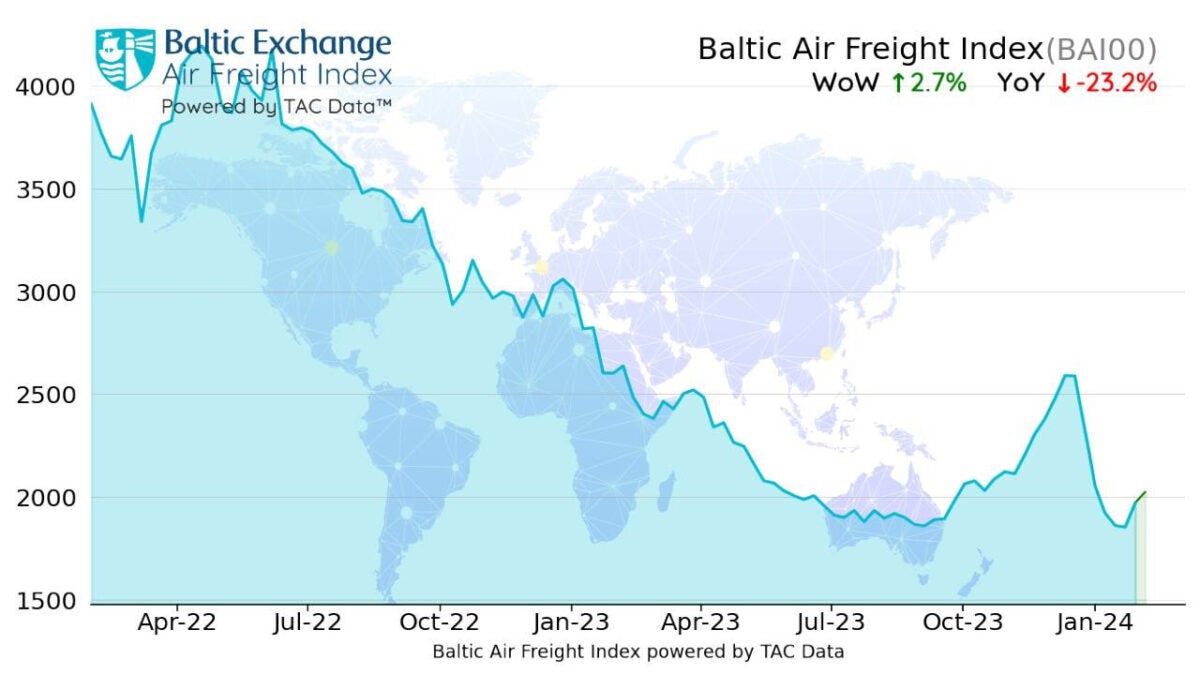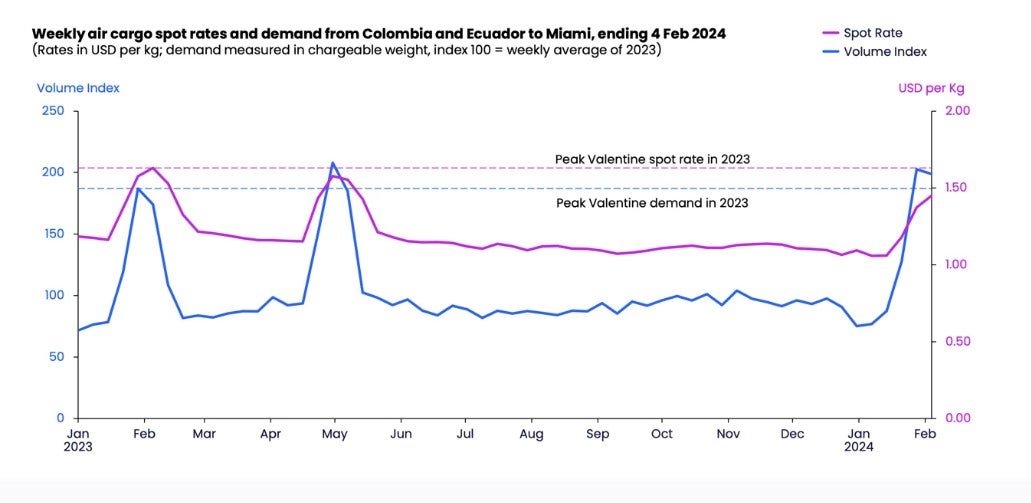Air cargo volume growth at the end of 2023 has carried over into a normally quiet shipping period for reasons that include retailers finally rebuilding inventories, an early Chinese New Year, flower demand for Valentine’s Day and longer ocean transits as vessels avoid the Red Sea shortcut from Asia because of rebel attacks.
Demand grew more than 10% year over year (y/y) in January, when shipment activity usually dies down from the year-end holiday rush, according to researchers Xeneta and WorldACD. During the first week of February, tonnage and rates continued to inch forward, other data providers reported. But demand gains are not universal, with regions experiencing strong growth bringing up the global average.
It should be noted this year has an advantage because January growth came against a low floor in 2023 and that Chinese New Year occurred earlier than this year’s start on Feb. 10. Chinese exporters push out shipments a couple of weeks before closing factories for the long holiday, which means there were about 10 days with very limited airfreight movement out of China in January 2023.
The positive development builds on momentum since early September that culminated with volumes growing about 10% — the biggest year over year increase in two years. The International Air Transport Association (IATA) said airfreight traffic, factoring in distance traveled, fell 1.9% for the full year, an improvement from the prior estimate of a 3.8% decline that was driven by the market surge after nearly 18 months of decline and doldrums.
Estimates for airfreight growth range in 2024 from 2% to 5%, but the continuing influx of passenger widebody capacity, especially in the Asia-Pacific region, as airlines reset after the pandemic is expected to put pressure on load factors and rates. Xeneta said the amount of space filled on airliners fell three points in January to 56%.
IATA’s latest report showed global cargo capacity was 11.3% higher at the end of 2023 than a year earlier. Passenger belly space increased 36% for the full year, while capacity from all-cargo aircraft dipped marginally.
After dipping to start the year, rates have climbed the past three weeks ahead of Chinese New Year. The price to ship goods by air is down 23% y/y compared to down 29% a month ago. The pace of decline has slowed from 38% y/y in January 2023. Outbound lanes from Hong Kong and Shanghai to Europe were the biggest gainers, a likely effect of the Red Sea disruption to ocean traffic, with rates nearly caught up to last year’s level.
Prices are expected to dip as pre-Lunar New Year demand for ocean and air freight eases. Some freighter flights to China and Taiwan have been suspended during the pause in production. Demand will tick up when Chinese factories reopen around Feb. 26, but in March container shipping will go into its slow season, which means cargo owners will feel less pressure to utilize air transport.

The threat on Red Sea shipping lanes has had a modest effect on air cargo rates so far despite accounts of shippers converting some merchandise transport from ocean to air, or hybrid sea-air moves, because of slower transit times and fears of container shortages in Asia. Some shippers are utilizing transcontinental rail service from China to Europe as an ocean alternative. Container shipping prices have tripled in the past two months, but airfreight has been more stable. A large surplus in ocean and air capacity means an uptick in airfreight isn’t materially impacting short-term rates, experts say.
“We saw a relatively strong January from a volume perspective, but the market fundamentals have not changed. This is not consumers buying more, it is likely linked to Red Sea disruption as well as the upcoming Lunar New Year and some indicators that the general cargo market is busier than expected,” said Niall van de Wouw, Xeneta’s chief airfreight officer. “However, the consensus seems to be that this will not produce a long-term positive effect on airfreight. Once the initial nerves and uncertainty subsides, stability will return once shippers simply accept that ocean freight may just take two weeks longer, causing the need for airfreight to then dwindle.”
Xeneta said it observed an unusual surge in air cargo volumes from China and Vietnam to Europe for three consecutive weeks in January, surpassing even their peak season highs in November and early December. That resulted in spot rates from Northeast Asia to Europe rebounding by 11% to $3.42/kg in the last week of January.
Freightos, another price reporting agency, published data showing China-North America rates climbed 14% in the past week to more than $6/kg and are slightly higher than in early December. And while China-Northern Europe prices dipped, Middle East-to-Northern Europe prices are still 20% higher than in mid-January, possibly reflecting some ocean to sea-air shift.
The flower trade ahead of Valentine’s Day drove a spike of more than 55% in volumes from Central and South America to North America since late January, according to WorldACD. Latam Group said it moved a record 25,000 tons — equivalent to 575 million flower stems — from Colombia and Ecuador to North America and Europe in a 21-day period, a 36% increase compared to the same period last year. The airline said it increased flight frequency and temporarily leased two additional Boeing 767s, for a total of 21 freighters, to meet the high demand during the peak season.

In the week ending Feb. 4 the air cargo spot rate from Colombia and Ecuador to Miami increased by 37% to $1.45 per kg compared to three weeks prior, just before the start of the peak season. Despite carriers increasing capacity through additional flights, it has not been enough to keep pace with the surge in demand, as measured by the chargeable weight, which soared 128%, Xeneta said. Capacity increased by 81% in the same period.
Looking Ahead
The macroeconomic outlook is mixed and analysts say 2024 is likely to be a transition year from the freight recession, with the real recovery occurring in 2025.
Many European economies are at or near recession levels, with higher inflation than in the U.S., while the Chinese economy has slowed below its historical trend. Industrial production and new export orders continue to stagnate in many parts of the world.
On the positive side, U.S. freight and warehousing activity is starting to revive from a nearly two-year recession, thanks to the resilience of the U.S. economy. Containerized imports posted their highest month over month growth for January in seven years, according to Descartes Datamyne, a data analytics firm. Meanwhile domestic transportation prices increased for the first time since June 2022 and retailers appear to be restocking after a busy holiday shopping season and spending the past year working off excess inventory, according to the latest Logistics Managers Index. Retailers have mostly returned to the just-in-time inventory model that existed before the pandemic, which should provide more steady demand for freight transportation, including airfreight.
According to the Wall Street Journal, the average warehouse vacancy rate across the United States reached 5.2% in the fourth quarter, a steep rise from 4.6% the previous quarter and a sign that retailers have sold off surplus inventory.
RECOMMENDED READING:
Sea-air routes gain as bypass option for Red Sea shipping delays











